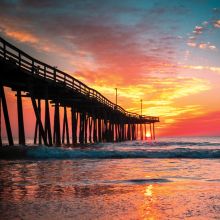
Ocean piers might look like bridges to nowhere, but once you walk the planks, you’ll find that piers are portals to a whole other world over the water.
Well beyond the shoreline, teetering in the air at seagull level, it’s quieter – conversations, the zing of lines casting, even squeals of fish-catching delight seem to dissipate into the breeze – and it smells saltier – salt mixed with aromas of sunscreen, fish slime and a twinge of bait bits rotting in the sun. There’s that slightly dizzying sensation, too, whether from the swells slapping the pilings and gently rocking the structure you stand on or from the effects of peering over the railings down into the watery green depths.
Built for recreational fishing, ocean piers are the perfect places for all levels of experience. It’s easy for beginners to learn what to do and catch something, yet there are endless challenges for experienced anglers. Pier fishing is relatively inexpensive, with day, week and annual passes available and no license required, making it affordable to take the whole family. Plus, plentiful amenities are on site.
For the fishermen on the piers, economic and social status seem to fade away, each pier establishing its own distinctive subculture and code of order. Local pier rats and first-time fishermen, retirees and teenagers, professionals and blue-collar workers line up side by side along the weathered railings, lines in the water, talking when the fish aren’t biting and making sure the newbies know what to do.
Historically, piers were strictly for fishing and sightseeing. The local piers sell inexpensive walk-on passes, perfect for an after-dinner walk, to break up the monotony of a beach day, to look for migrating whales, dolphins, sea turtles and birds or to feel the full force of a coastal storm. These days piers have expanded their social reach to include eating, drinking, dancing, gathering and even getting married right beside the ocean. They are places for Fourth of July fireworks, surf contests and local events.
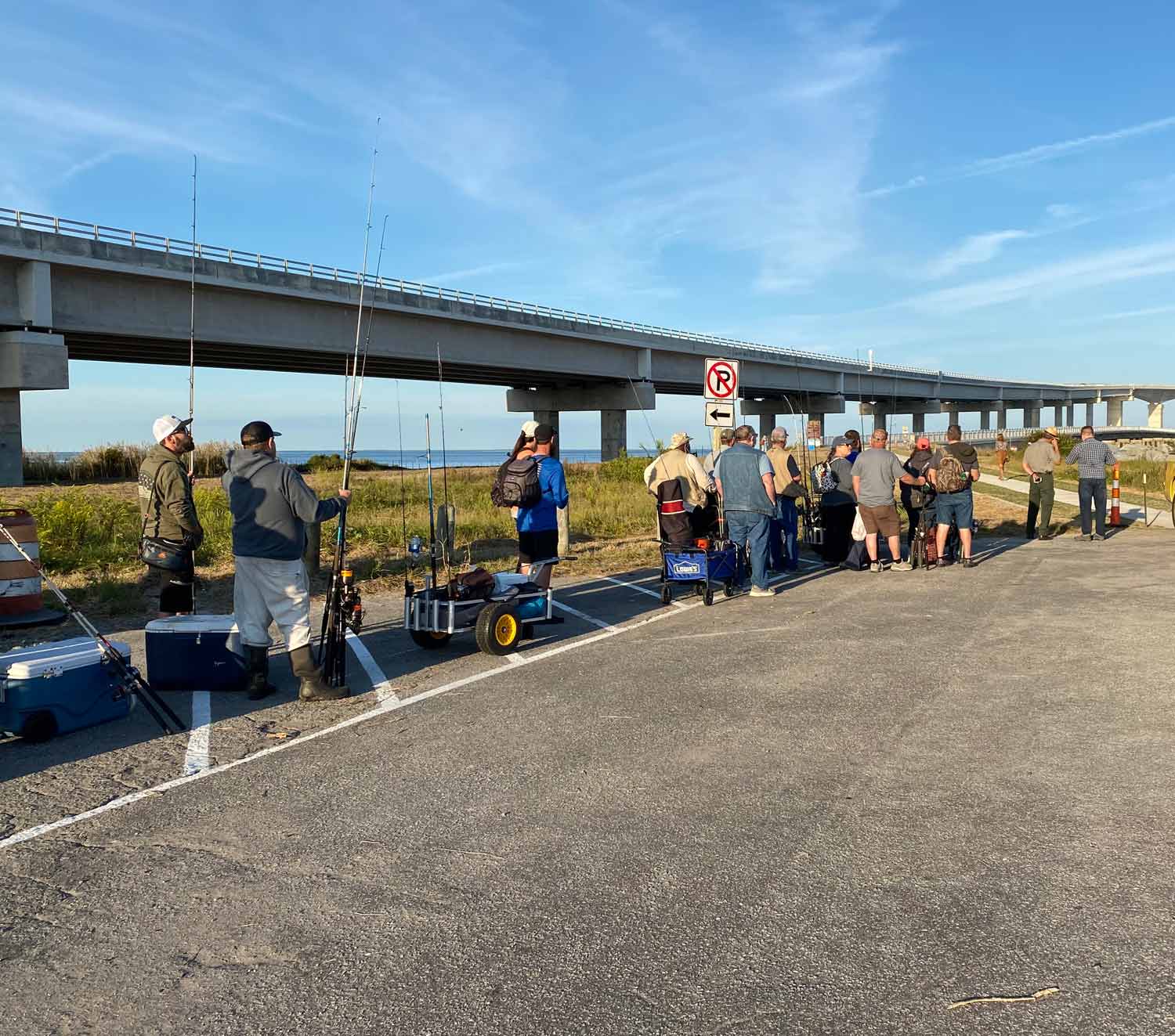
Piers are long-ingrained parts of most any coastal community. They have been around on the North Carolina coast since the late 1930s, but they are understandably difficult and expensive to maintain in the face of nor’easters, hurricanes and other storms. In 1980 there were 36 piers on the North Carolina coast. Today, there are less than 20, seven of them on the Outer Banks.
Though often shorter than they started, the piers that remain are pillars, literally, of the Outer Banks communities, placeholders of fading traditions. The old weathered wooden piers show the character of each season and storm and each busy, sun-drenched day. The lopsided planks, the notches dug into worn handrails to hold fishing rods, the initials scraped into benches, the crusty fish-cleaning stations, the hills and valleys of the walkways – all of it a beloved throwback to a simpler time.
Equally loved is our newest pier, Jennette’s Pier, a marvel of concrete engineering, committed to keeping the love of pier fishing alive and combining that with sustainable construction and environmental education required for our modern times. We cherish Jennette’s for its commitment to educating this and the next generation about coastal stewardship. Every plank and bench on the pier bears a community member’s name, revealing the strong local support for this bridge of past and future.
Whether you’re fishing or sightseeing, learning about the ocean and its inhabitants or eating, drinking and listening to live music, if you want to experience the world of Outer Banks fishing piers, here is where to do it.
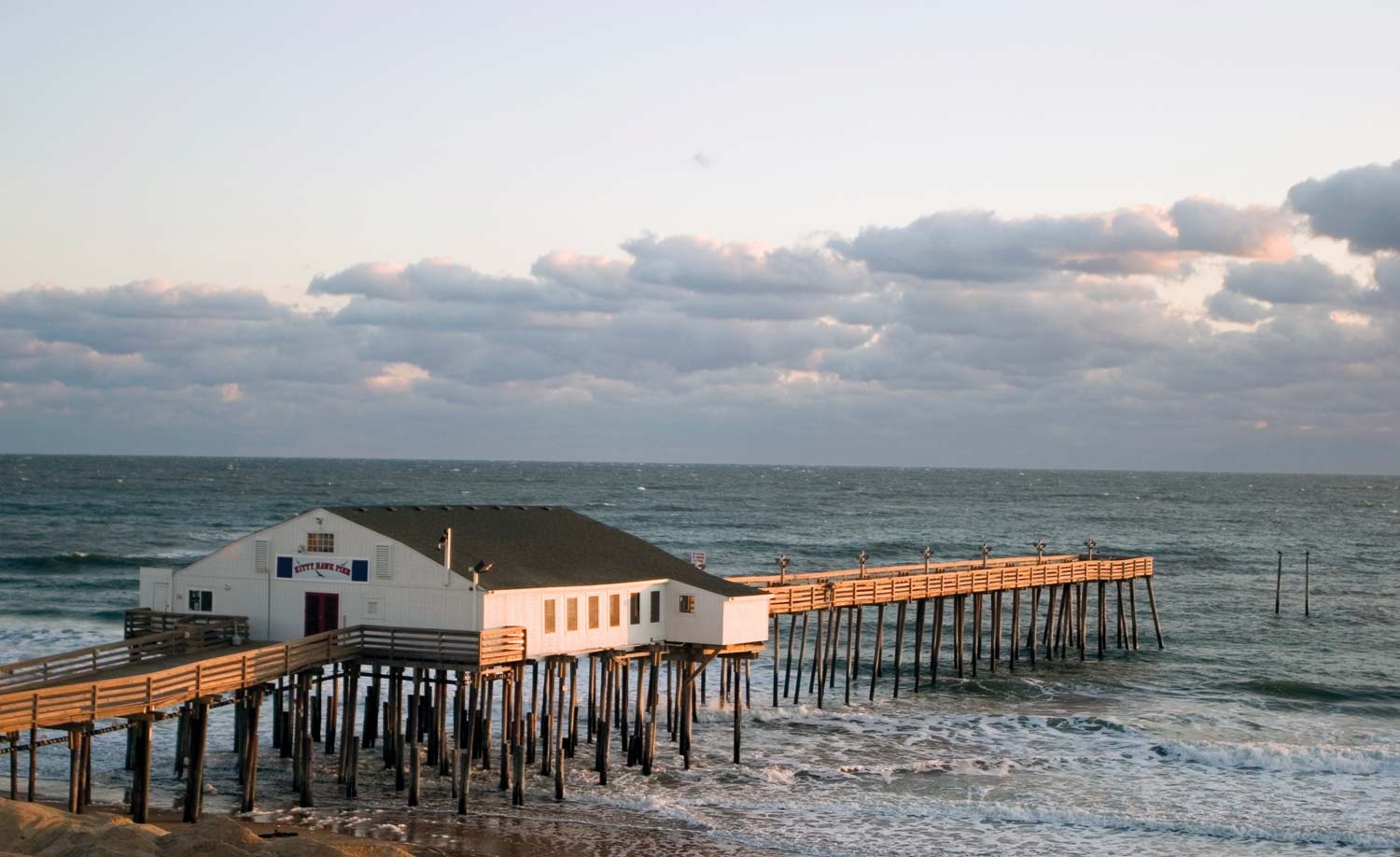
OCEAN PIERS
Kitty Hawk Fishing Pier
Where: MP 1, Kitty Hawk
Built: 1953
Length: 245 feet
Summer hours: Fishing is allowed only for guests of Hilton Garden Inn in Kitty Hawk.
In the 1950s and ’60s Kitty Hawk Pier was one of the most popular local fishing piers, a hotspot known for its record-breaking catches and its restaurant. The pier has withstood many a hurricane, including Isabel, which washed away a large portion of the structure, forcing it to close for several years. The owners of Hilton Garden Inn purchased the pier in 2006 and made the repairs, using as many of the original materials as possible for the pier house. It reopened in 2008 as a private ocean pier, open to guests of Hilton Garden Inn for fishing and sightseeing. The historic Kitty Hawk Pier House is available for rent for weddings and other special events of up to 150 people.
Avalon Fishing Pier
Where: MP 6, Kill Devil Hills
Built: 1958
Length: 420 feet
Summer pier hours: 6 a.m. to midnight
When Avalon Pier was built in 1958 it stretched out more than 700 feet into the ocean. Battered by many hurricanes, the original pier survives, though it’s been whittled down to 420 feet. It’s still a great fishing spot. Rumor has it a sailfish was caught off the end of this pier in the 1990s after a weeks-long east blow. Avalon Fishing Pier has always been a locals’ fishing haunt, and there’s a loyal group of local sunrise-watchers gathered here every morning. Previously a somewhat rough-around-the-edges hangout, today Avalon Pier has upped its family-friendly game with Stonefish BeachBar offering indoor bar seating and two levels of outdoor seating right on the ocean, frequent live music and an upgraded arcade. The pier has a full-service tackle shop that rents fishing gear and sells tackle and bait. The Town of Kill Devil Hills’ 4th of July fireworks are also launched here.
Nags Head Fishing Pier
Where: MP 12, Nags Head
Built: 1947
Length: 850 feet
Summer pier hours: 5 a.m. to midnight
Nags Head Fishing Pier is the oldest existing Outer Banks pier and the second-oldest pier next to the original Jennette’s Pier. The restaurant was added to the pier in the 1970s. Current owners Lovie and Andy McCann bought the pier in 1985 and have operated the fishing pier and the Pier House Restaurant since then. The Pier House Restaurant has long been a favorite for breakfast, lunch and dinner with an ocean view, and they will gladly cook what you catch on the pier. In 2014 the McCanns added Capt. Andy’s Tiki Bar & Grill, which allows you to enjoy drinks, food and live music outside right by the ocean, in the shade or in the sun. Nags Head Pier is the site of the Town of Nags Head’s annual 4th of July Fireworks show. The pier house has a tackle shop selling bait and tackle and renting equipment.
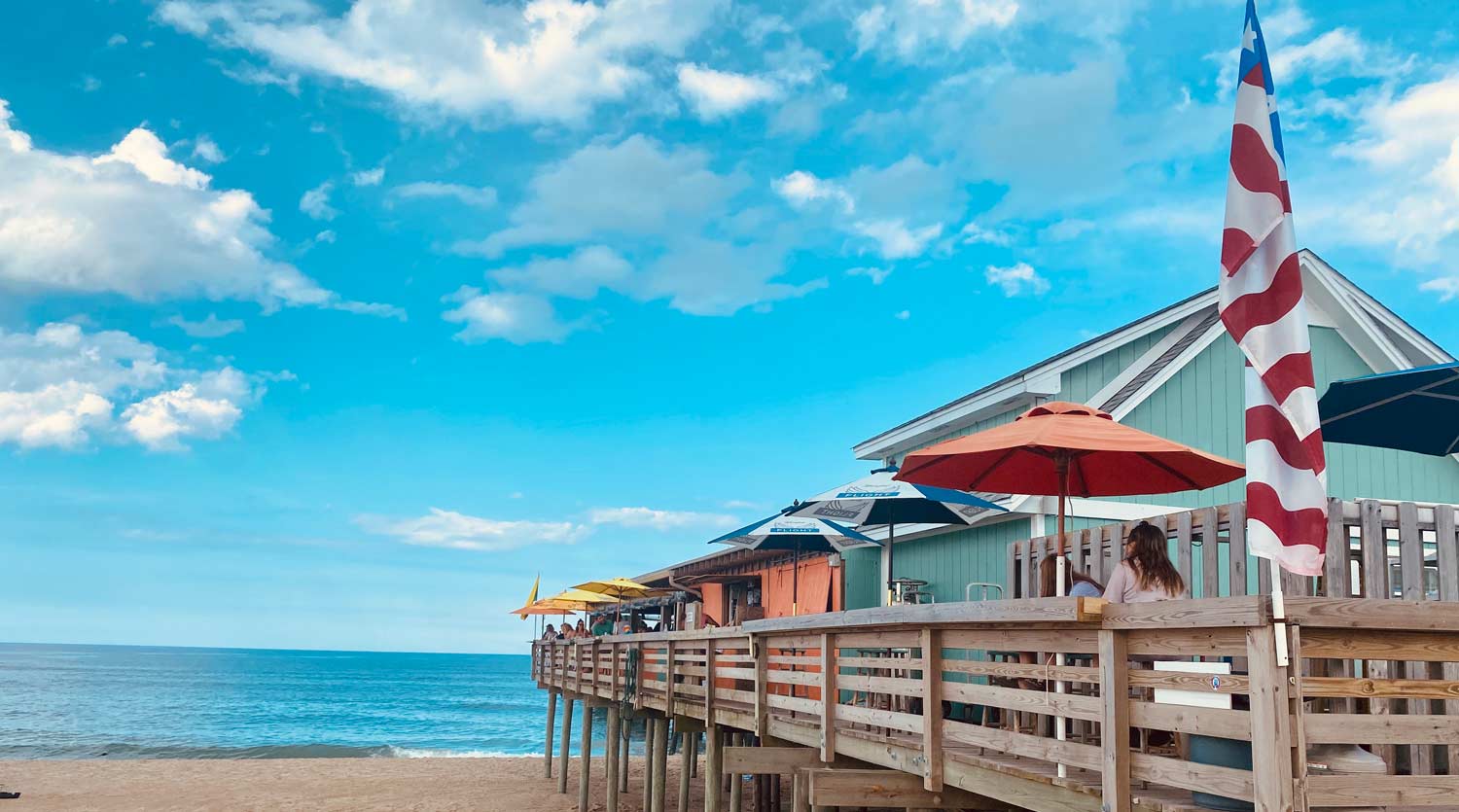
Jennette’s Pier
Where: MP 16.5, Nags Head
Built: 1939, 1945, 2011
Length: 1,000 feet
Summer pier hours: 6 a.m. to 10 p.m. Family Fishing classes are offered Monday through Friday at 9 a.m. When Warren H. Jennette Sr. had the first Jennette’s Pier built in 1939, the builders used untreated, permeable lumber, which quickly deteriorated in the ocean environment. In 1945 Jennette took the whole pier down and rebuilt it. The pier had changed hands over the years and was sold to the North Carolina Aquarium Society in 2002, and the next year it was all but wiped out in Hurricane Isabel. The proper[1]ty was then donated to the State of North Carolina with plans to rebuild the pier. In 2011 the state opened the $25 million, 1,000-foot concrete pier that’s known as Jennette’s Pier today. Able to withstand hurricanes, the pier is part of the North Carolina Aquariums and is a green facility using geothermal heating and cooling, innovative wastewater treatment and solar power. It is an educational facility as well as a family-friendly fishing pier, offering Family Fishing classes, educational programs and summer camps for kids. Jennette’s has aquariums with informational signage, a huge gift shop, a snack shop, and an upstairs event and banquet facility with amazing ocean views. The pier has a tackle shop selling bait and tackle and offering rentals. Because it’s concrete instead of uneven wooden planks, this is the most handicap-accessible pier.
Outer Banks Fishing Pier
Where: MP 18.5, Nags Head
Built: 1958
Length: 600 feet
Summer pier hours: 24 hours a day
Outer Banks Fishing Pier is a much-loved fishing pier in South Nags Head. Built in 1958 by a West Virginia man, the original pier washed away in the Ash Wednesday Storm in 1962 and was rebuilt a short time later. In 1970 Garry and Mary Oliver purchased the pier and have maintained it as a locals’ favorite for 54 years. Many trophy fish have been caught off this pier. In 2012 the Olivers added Fishheads Bar & Grill, the first of the local pier-based bars. It was a huge hit, and Fishheads is one of the most popular dining and drinking spots on the Outer Banks. It offers covered and uncovered seating right by the ocean and frequent live music. The pier house has a tackle shop selling bait and tackle and renting equipment.
Rodanthe Pier
Where: Atlantic Drive, Rodanthe
Built: 1960
Length: 450 feet
Summer pier hours: 6 a.m. to midnight
A little off Highway 12 down Atlantic Drive, Rodanthe Pier, which used to be known as the Cape Hatteras Pier, has a more quiet and remote feel. Once more than 1,000 feet long, this pier, too, has lost some of its length in storms but still stands as an excellent fishing location in the warmer waters of Hatteras Island. Despite being one of the shorter local piers, due to its location, it stretches farther out into the Atlantic than any other Outer Banks pier, and it’s known for red drum catches. The pinkish-colored pier house, which can be seen in the movie Nights in Rodanthe, offers a tackle shop, snacks and drinks and a game room. Rodanthe Pier frequently has live music and sells drinks on the pier in the summer, and it’s a popular summer hangout for locals and visitors whether they’re fishing or not. Their pier house sells bait and tackle and offers rentals.
Avon Fishing Pier
Where: Highway 12, Avon
Built: 1963
Length: 630 feet
Summer pier hours: 6 a.m. to 10 p.m.
Avon Fishing Pier was built in 1962 by a local family, and it was said to be more than 1,000 feet long. It has always been a fishing hotspot known for its excellent drum fishing in the fall. Owned by the National Park Service and operated as part of Koru Village, the pier has seen its fair share of storms, which have created a rollercoaster-like stretch of wooden planks. Like all wooden piers, it wobbles with the waves, but the pier is secure and the fishing is great. Isabel, Irene and Sandy were particularly hard on the pier, which has reduced the length to around 600 feet. Today Avon Fishing Pier offers a bait and tackle shop, rod rentals and a gift shop. Avon Fishing Pier is the site of a huge fireworks show on the 4th of July.
Eat, Drink and Socialize at the Pier
Stonefish BeachBar
Avalon Pier, Kill Devil Hills
Lunch and dinner, bar, live music, two levels of deck seating, indoor seating, arcade avalonpier.com/stonefish-beachbar
Capt. Andy’s Oceanfront Tiki Bar Pier House Restaurant
Nags Head Fishing Pier, Nags Head
Breakfast, lunch and dinner, bar, live music, indoor and outdoor seating nhpierrestaurant.com
Fishheads Bar & Grill
Outer Banks Fishing Pier, Nags Head
Lunch and dinner, bar, live music, deck seating fishheadsobx.com
Rodanthe Pier
Live music, beer, sodas, ice cream facebook.com/rodanthepier
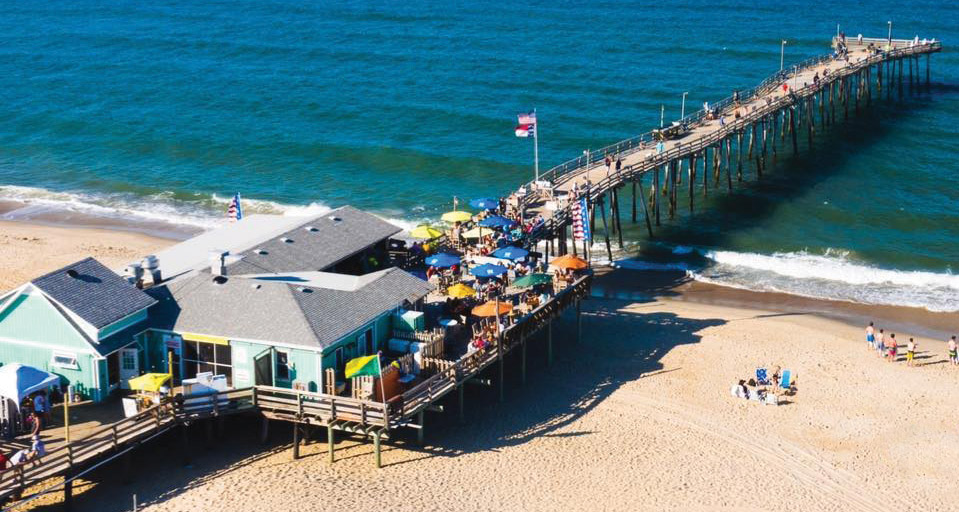
Soundside Piers and Bridges
Besides ocean piers, on the Outer Banks there are bridges and soundside piers that put you over the waters of the Croatan or Roanoke sounds and into Oregon Inlet. These are lucrative fishing spots, often crowded with anglers. Fishing at these local spots will require an N.C. Coastal Recreational Fishing License because they are not covered by a blanket license. Amenities are few – portable toilets and in some cases shade. Check with the local tackle shops about what’s biting and what baits are working best. Bring everything you’ll need – food, water, sunscreen, etc. These proven fishing spots are open 24/7.
Bonner Bridge Pier
N.C. Highway 12, North End of Hatteras Island
For decades the catwalk on the southern end of the Bonner Bridge was a fishing hotspot in Oregon Inlet, where the ocean and sound waters converge. When the Bonner Bridge was torn down, replaced by the Basnight Bridge, the state kept the southernmost portion of the Bonner Bridge roadway as a pier. It runs parallel to the new bridge and is 1,046 feet long, extending north into the inlet. The old bridge pilings and bases provide excellent fishing grounds. Park in the big parking lot on the south side of the Basnight Bridge.
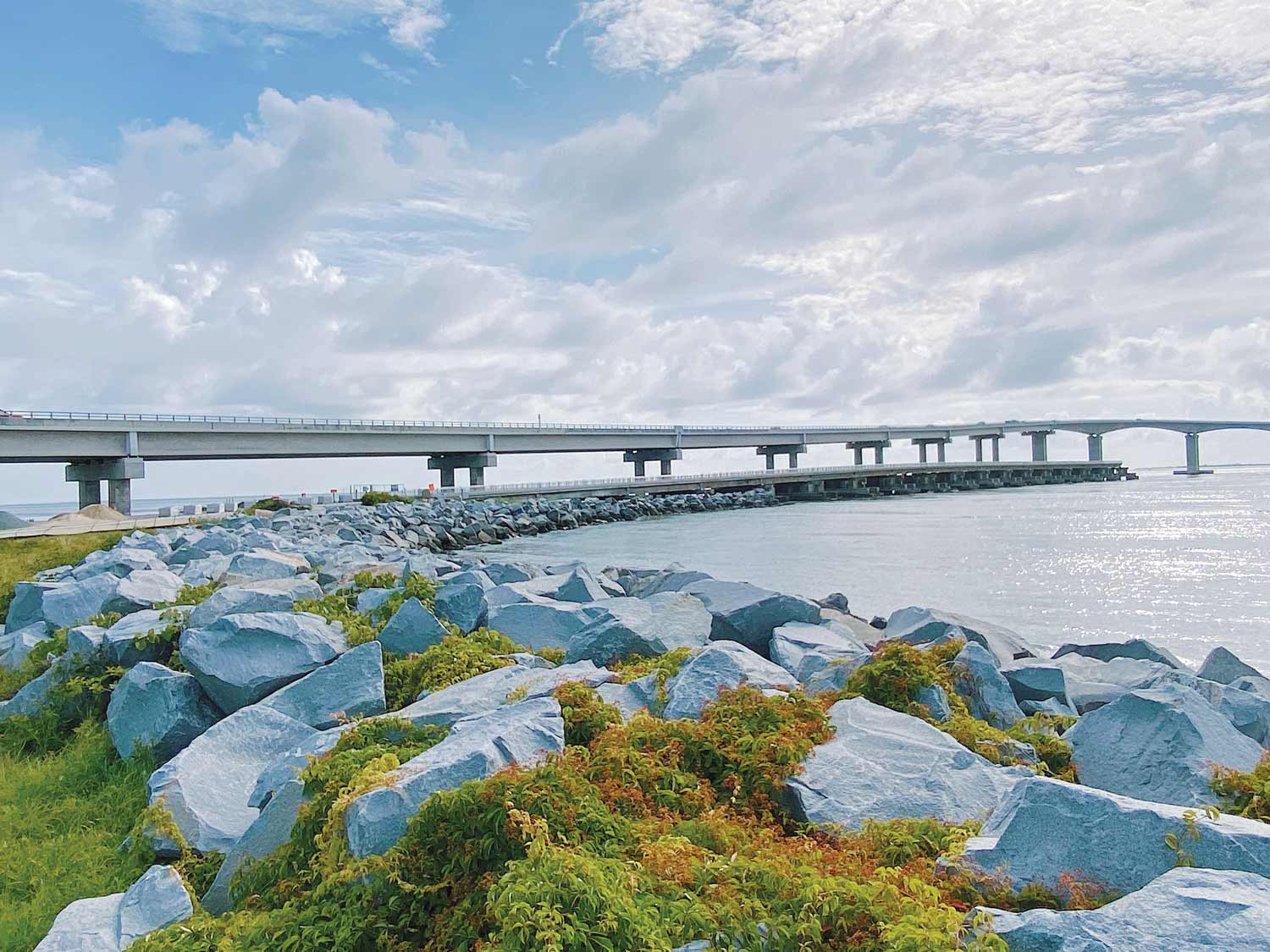
Washington Baum Bridge Pier
1205 U.S. Highway 64, Manteo
Under the bridge that spans Roanoke Sound from Roanoke Island to Nags Head is a nice dock and pier of several hundred feet. There are benches and railings and partial shade. Look for it next to the boat ramp across the street from Pirates Cove Marina.
Melvin Daniels Bridge
7711 S. Virginia Dare Trail, Nags Head
Known as The Little Bridge, this bridge on the Manteo/Nags Head Causeway has a catwalk on the southern side that is a popular fishing spot. It has restroom facilities, a covered picnic area and handicapped-accessible features.
BeBop’s Multi-Use Pier
9220 U.S. Highway 64, Manns Harbor
This 200-foot pier over the Croatan Sound in Manns Harbor on the west side of the William B. Umstead Bridge is a lucrative spot for fishing away from the beach crowds. Opened in 2010, it is named for Betty Dean “BeBop” Fearing, a local outdoorswoman whose family donated the land for the pier. It is handicapped accessible and offers shade in a covered pavilion.
Get Hooked on Pier Fishing
By Daryl Law, Jennette’s Pier
There’s no faster way to feel the excitement of catching a saltwater fish than to go pier fishing along the Outer Banks. Affordable, fun and family-oriented, this type of angling is easy and rewarding – you almost always catch something when you go bottom fishing during the summer.
If you’re not an experienced angler, don’t be intimidated by this type of fishing. It can be easy and family-friendly, and usually there is an experienced angler around who will be glad to help you. Part of the beauty of pier fishing is that it offers an open area where people can meet and socialize.
Here are some tips to get you started:
Don’t worry about purchasing fishing licenses; all piers have a blanket license so that everyone is covered.
Most piers have rental rods or can sell you what you need to catch fish.
Standard double bottom rigs with small, No. 2 hooks are a saltwater angler’s best friend.
Popular baits are fresh shrimp, cut mullet, blood worms and artificial Fishbites that come in a variety of “flavors.” Start with a standard double bottom rig baited with fresh shrimp and cut mullet. These set-ups can produce catches of bluefish, croaker, drum, flounder, pigfish, pinfish, pompano, puffers, sand perch, sea mullet and spot.
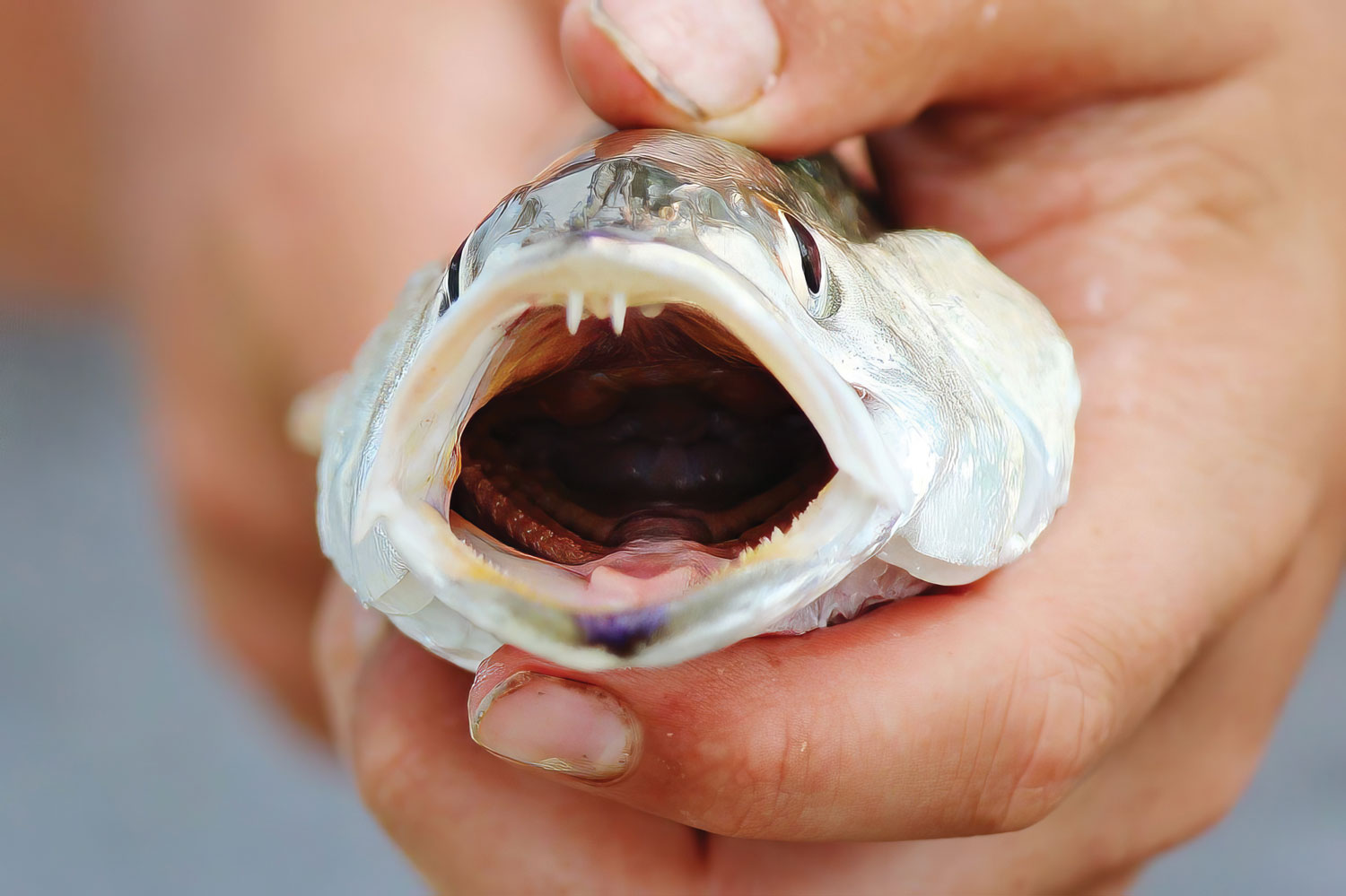
If you’re not going to keep the fish, try to return it to the water unharmed as soon as possible. Wet your hands or use a wet fishing towel when handling your catch, which helps conserve the fish’s protective coating or “slime.” Use pliers to gently remove the hook from its mouth before returning it to the sea. If you’re experiencing a problem, ask someone near you to assist.
If you’re looking to catch dinner, be sure to know the size requirements and bag limits – even bluefish are regulated these days. The FishRules mobile app makes it easy to see these limits, or go to deq.nc.gov/marine-fisheries/recreational size-and-bag-limits/open
Consider cleaning your fish on the pier because experienced fishermen nearby may give you pointers and offer help. In addition, it’s OK to return the head and guts to the ocean so you don’t have to leave those in the trash can of your rental property or hotel.
Another active type of pier fishing is jigging for blues and Spanish mackerel with the world-famous Got–Cha plugs. These neon orange and white lures with sharp double treble hooks are standard lures at ocean piers. They come in different color combinations – try the Electric Chicken for sure.
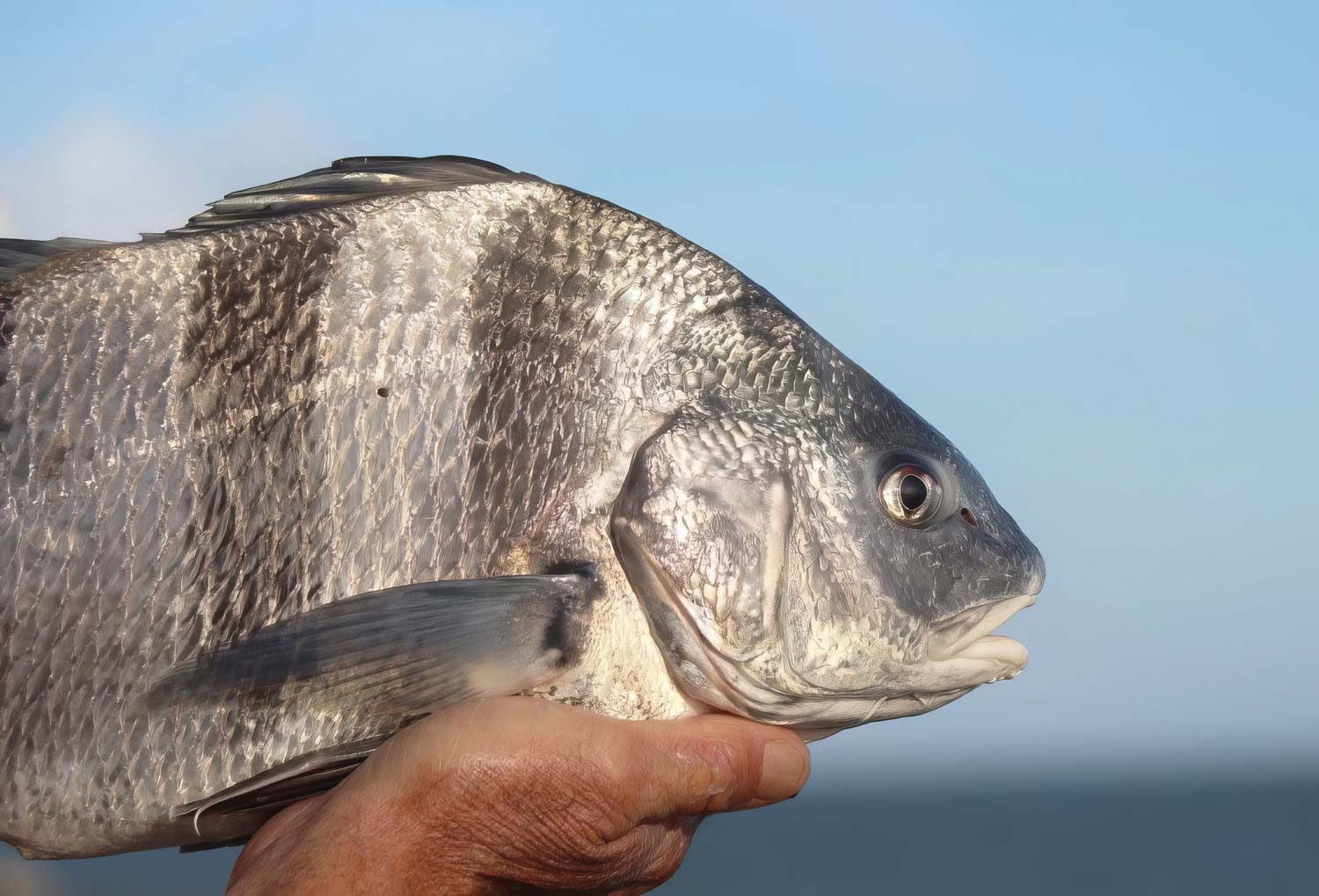
More experienced anglers may target spadefish, sheepshead and triggerfish with hand-tied rigs and larger hooks baited with live sand fleas that are dropped down along the barnacle-encrusted pilings. Live bait fishermen look to draw cobia and king mackerel to the bite with their two-rod systems set out from the end of the piers that allow pin rig fishing.
A big part of fishing is the wait, so be patient. This offers a great opportunity to teach children about the virtue of patience. To make it more fun, be sure to have cold drinks and snacks for everyone. A chest-style cooler works well on the pier because it can hold your bait, drinks and hopefully your catch on ice all day long.
Sunscreen, hats and sunglasses are critical for comfort.
A Simple Starter Setup for Pier Fishing
By Capt. Tony Lombardi
For beginner pier fishing, you want to keep it simple. For starters, you want a good all-around rod and reel setup. The best starter rod will be a 7- to 8-foot rod with a medium flexibility. I like a one-piece rod, but a two-piece allows for better storage. This size and style rod should give you the sensitivity to feel a bite and enough backbone to reel in most local species. The reel should be loaded with a 12- to 15-lb. test monofilament line. Braided line is also an option.
The next part is tackle or rigging. The basic tackle setup will be a snap hook connected to the end of your main line with a standard two-hook bottom rig and a sinker. You can either tie the bottom rig directly to the main line or use a snap swivel. A snap swivel allows for a quick change for gear. But either method should work well.
Next you will need to decide on hooks and sinkers. Your tackle shop staff can help with the proper size and style of hook and sinker types. I suggest a simple #4 “J” hook and #2 or #3 pyramid sinkers depending on the waves and tides. The key to weight size is to just hold the bottom and not allow the weight and bait to move.
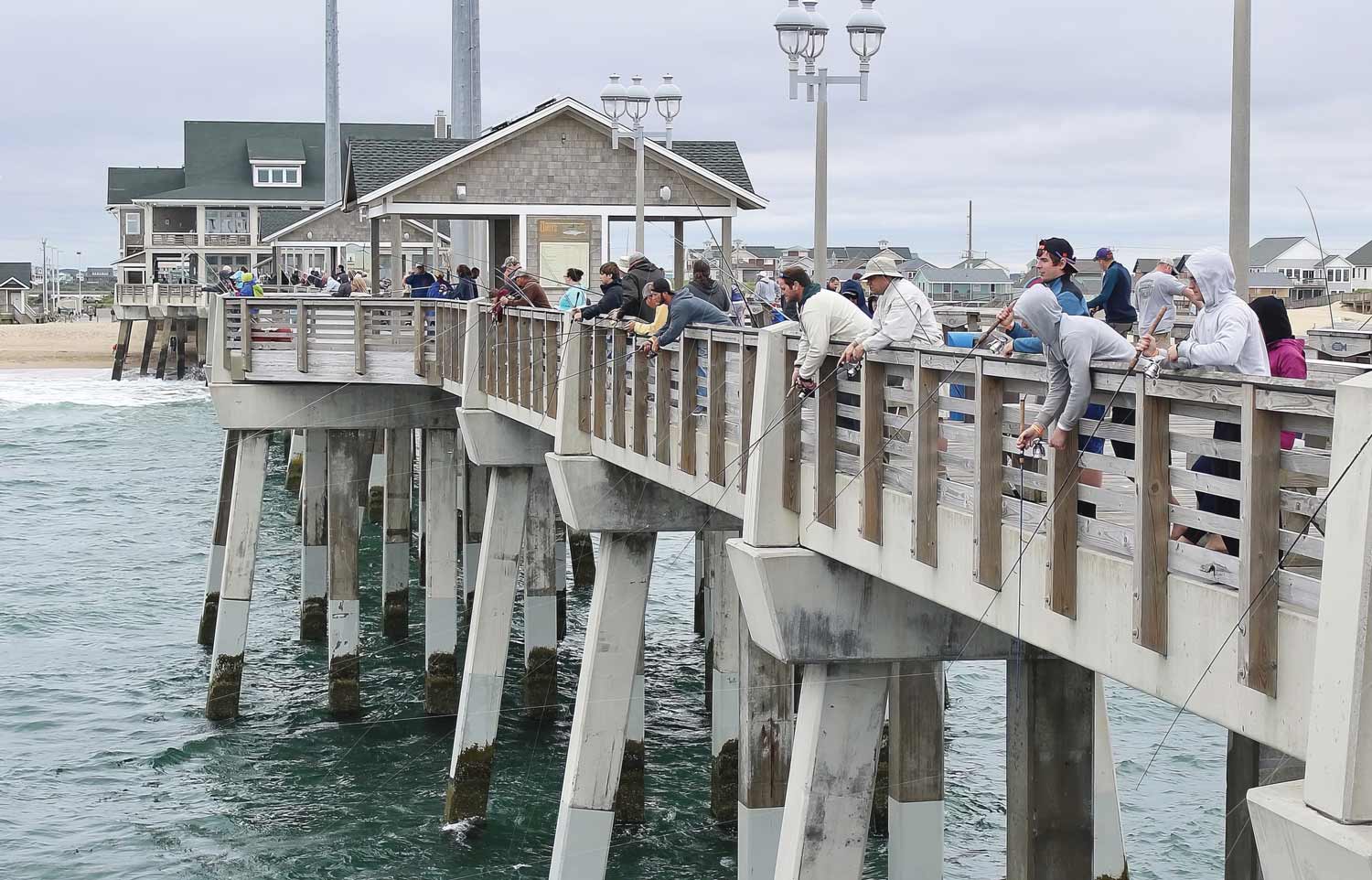
Next, you will need bait. There are many different types of baits to use, but to keep it simple, I suggest you pick up a bag of fresh shrimp. It seems everything eats shrimp so this is your best bet. If possible, make sure it is fresh not frozen as frozen bait shrimp loses its scent quickly. It is imperative that you keep it on ice in a cooler and not sitting in the heat or sun. I also recommend that you never use yesterday’s bait – buy fresh each day. And when baiting the hook only use a small piece of shrimp and leave the tip of the hook exposed. Use small pieces of shrimp, shell on, and make sure the tip of the hook is exposed.
In addition, you will also need a number of other things to complete your setup. A bucket is helpful for holding your gear. You’ll need a pair of pliers or hook remover, a bait knife, a tape measure, a small cooler for your bait and some rags.
So there you go: a simple starter setup. Sure, there are other items you could use to make your trip, but remember you are just getting started. There is plenty of time for you to experience fishing and then add to your tackle collection as you find things you like to try.
For a wealth of pier fishing tips from a lifelong angler, visit walkingangler.com.
Pier Fishing Etiquette
By Tony Lombardi
Safety is the first priority. Piers are safe, but hazards exist so it’s important to watch out for yourself and other anglers. Especially watch out for non-angling visitors and small children.
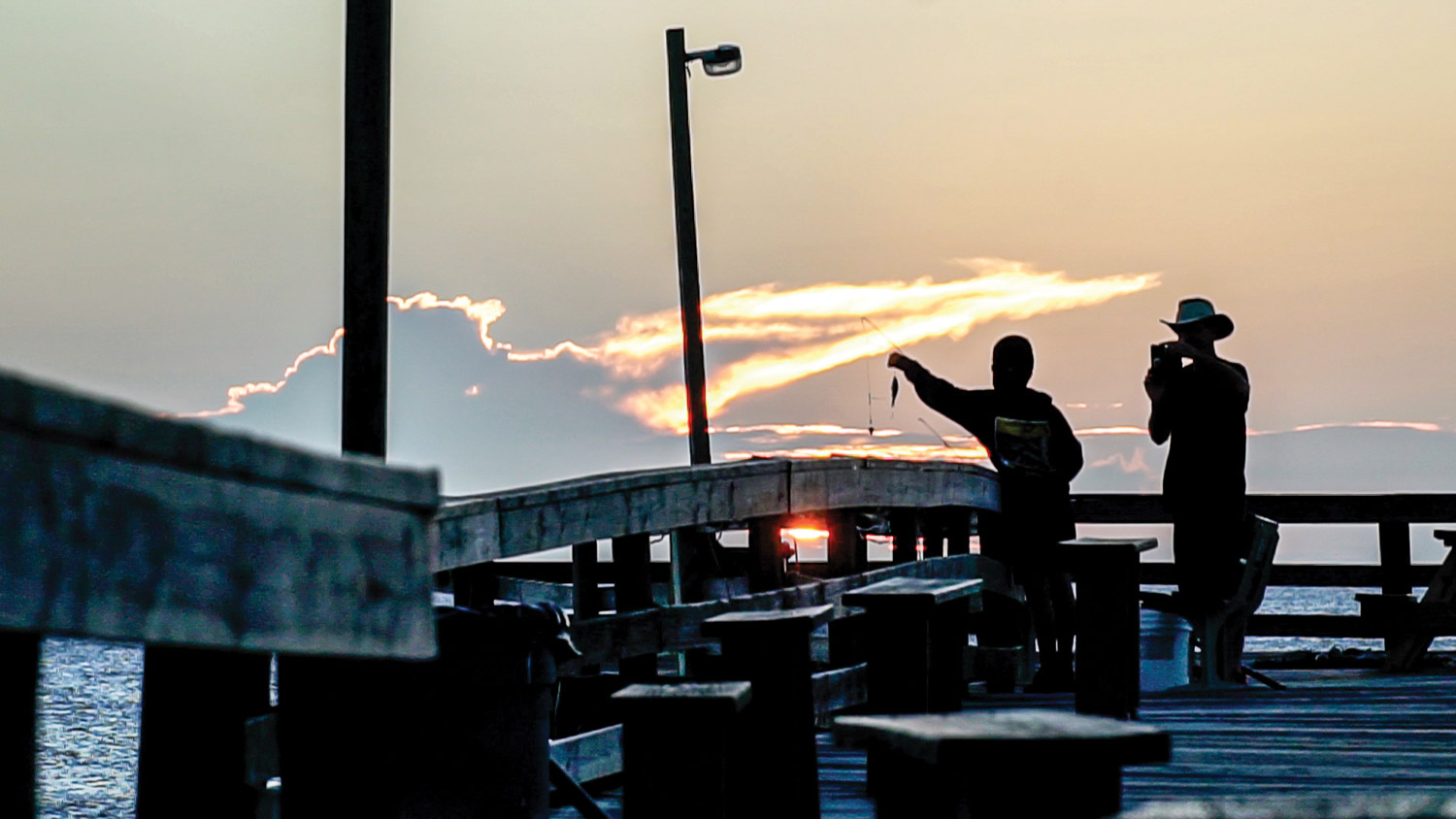
- Each pier has different rules about gear and equipment. Many piers have a two- or three-rod limit and require you to maintain control on your rods at all times. Be sure to learn them and follow the rules. If you don’t know, ask!
- Pick a spot and stay there. And keep your rods and gear close to the spot you selected. Move around only if you can do it safely and it does not interfere with other anglers.
- Remember to always leave room and don’t crowd other anglers. If possible, keep at least 10 feet apart to avoid interfering with others who are casting and to prevent lines from crossing in the water.
- Use proper casting techniques. Watch for others casting and don’t walk behind them. And when casting yourself, watch for others walking or fishing behind you.
- Pay attention: If your neighbor is reeling a big fish, bring your lines in to give them room to land their fish.
- Be courteous to other anglers. Loud music and noise can distract both the anglers and visitors. Keep the volume low.
- Maintain good housekeeping. Remove any trash and discard old lines and defective gear properly. Recycle your fishing line in the provided canisters or secure it well to throw away later.
- When you are finished fishing, share any unused bait with another angler (if it’s fresh enough for them to use). As the fishermen say, “Never use old, stale or yesterday’s bait.”
- Practice safe release methods. Any fish you plan to keep, store in a cooler on plenty of ice.
- Leave no trace. Clean up when you leave, throw out old bait scraps, pick up your trash, don’t leave hooks or old fishing line lying around.
- Finally, always try to leave the pier better than you found it – ready for the next angler to enjoy.


 Molly Harrison is managing editor at OneBoat, publisher of OuterBanksThisWeek.com. She moved to Nags Head in 1994 and since then has made her living writing articles and creating publications about the people, places and culture of the Outer Banks.
Molly Harrison is managing editor at OneBoat, publisher of OuterBanksThisWeek.com. She moved to Nags Head in 1994 and since then has made her living writing articles and creating publications about the people, places and culture of the Outer Banks.




